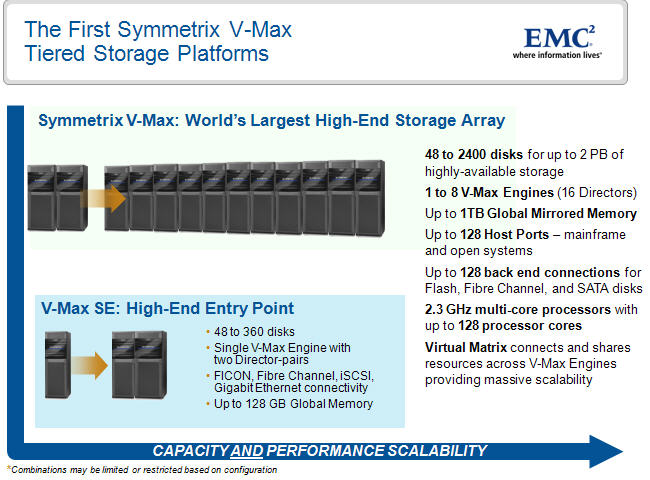EMC rolls out new high-end storage lineup; Aims to push data center flash adoption

EMC on Tuesday will unveil a new high-end storage lineup and a new architecture that's designed to be a bridge between legacy data centers and the newfangled virtual ones.
EMC, along with Cisco Systems, IBM, HP and a bevy of others, has been busy pushing the next generation data center. Virtualization, better servers and the need for cost savings are all driving the virtual data center push, which dictates that corporate information will reside in the cloud, on a corporate network and other locales. However, new servers often mean storage arrays follow. While the various approaches to the next-gen data center vary, the overarching goals are common: Save on energy, rackspace and get data where it needs to go as quickly as possible.
Also see; Saving energy in a flash. Solid state drives will be hot for keeping data centers cooler.
Enter EMC's latest architecture of its Symmetrix storage lineup. Symmetrix has only had three architectures since it was hatched in 1990, according to EMC president Dave Donatelli. The latest Symmetrix storage unit is designed to flexible enough to connect to virtualization layers---not surprising since EMC is the parent of VMware---and give customers mix and match capabilities between flash, Fibre Channel and SATA drives. The high-end storage market encompasses global 5,000 companies (think the data centers behind banks, reservation systems and the military).
The storage giant's new architecture---the EMC Virtual Matrix Architecture T and the first system, the EMC Symmetrix V-Max T system, is essentially designed to do three things:
- Scale out rapidly;
- Scale to tens of millions of IOPS (input/output per second) and 100s of petabytes of data and (the average company might have 2 to 6 petabytes according to Donatelli);
- Attach to cloud systems and save on energy costs;
- Push adoption of enterprise flash storage, a market EMC has targeted since January 2008.
And here's a look at the engine---dubbed the Symmetrix V-Max Engine---of EMC's latest storage effort:
The general idea is to get data center customers to start with one single EMC unit and build out to something that looks like this:
Perhaps more importantly, EMC is planning automation software called Automated Storage Tiering, or FAST. FAST is designed to automate data policies and read access patterns so data can be moved from flash to SATA hard drives as performance needs dictate.
As for the flash-SATA split, Donatelli said he sees 20 percent of data centers becoming flash-based. He also noted that demand for flash drives has been strong for EMC and the company has sold out its inventory the last two quarters. Donatelli explained:
We have seen significant flash adoption because there's faster overall performance, less power and a smaller footprint. We designed this to be perfect for flash, Fibre Channel and SATA drives. With the fully automated storage tiering we want to make sure that data that needs to be available quickly is always available on flash.
However, Donatelli noted that enterprise flash drives are more expensive than their disk drive counterparts, but deliver 30 times faster performance. For now, Donatelli sees data centers becoming 20 percent flash and 80 percent SATA. It's not like Fibre Channel and SATA drives will be tossed completely because not all data needs to be delivered in milliseconds. EMC's goal was to provide a storage line-up that would work for next-gen data centers as well as the legacy operations.
The general idea is to allow customers to mix and match traditional drives and flash counterparts to get the most value. When performance is needed a flash drive hits the mark. Ultimately, enterprise flash drives will gain more share because there's a smaller footprint and lower energy costs. "We do expect our FAST technology to help make the transition to flash faster," said Donatelli.
With EMC's Symmetrix V-Max system customers can choose what flavor storage they want---fibre channel, SATA or flash. From there, customers can add additional boxes and other flavors. EMC's FAST software---designed to ship later this year---will manage the what storage flavor is used based on customer requirements.
The system, which is available immediately, had 30 beta customers including Microsoft's adCenter unit and Unicredit.
More storage news:
